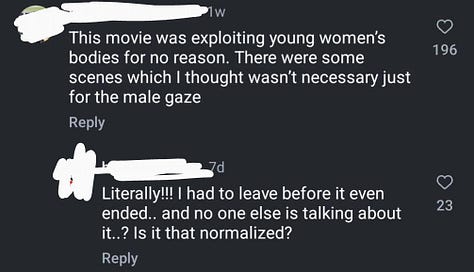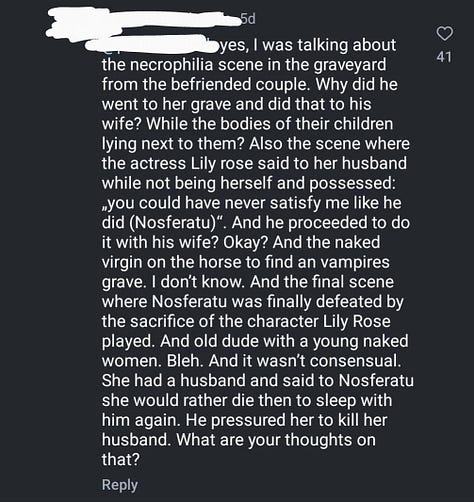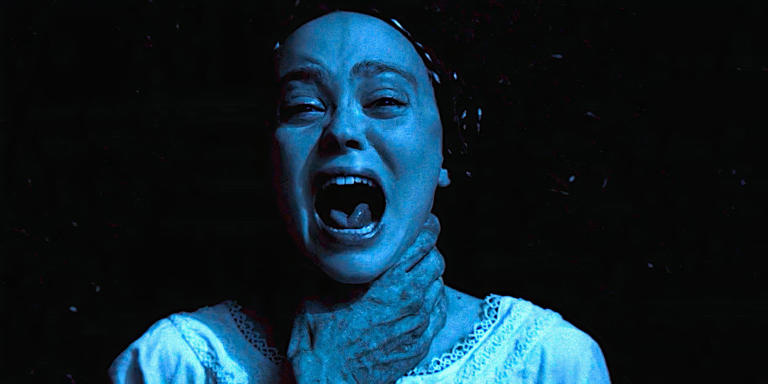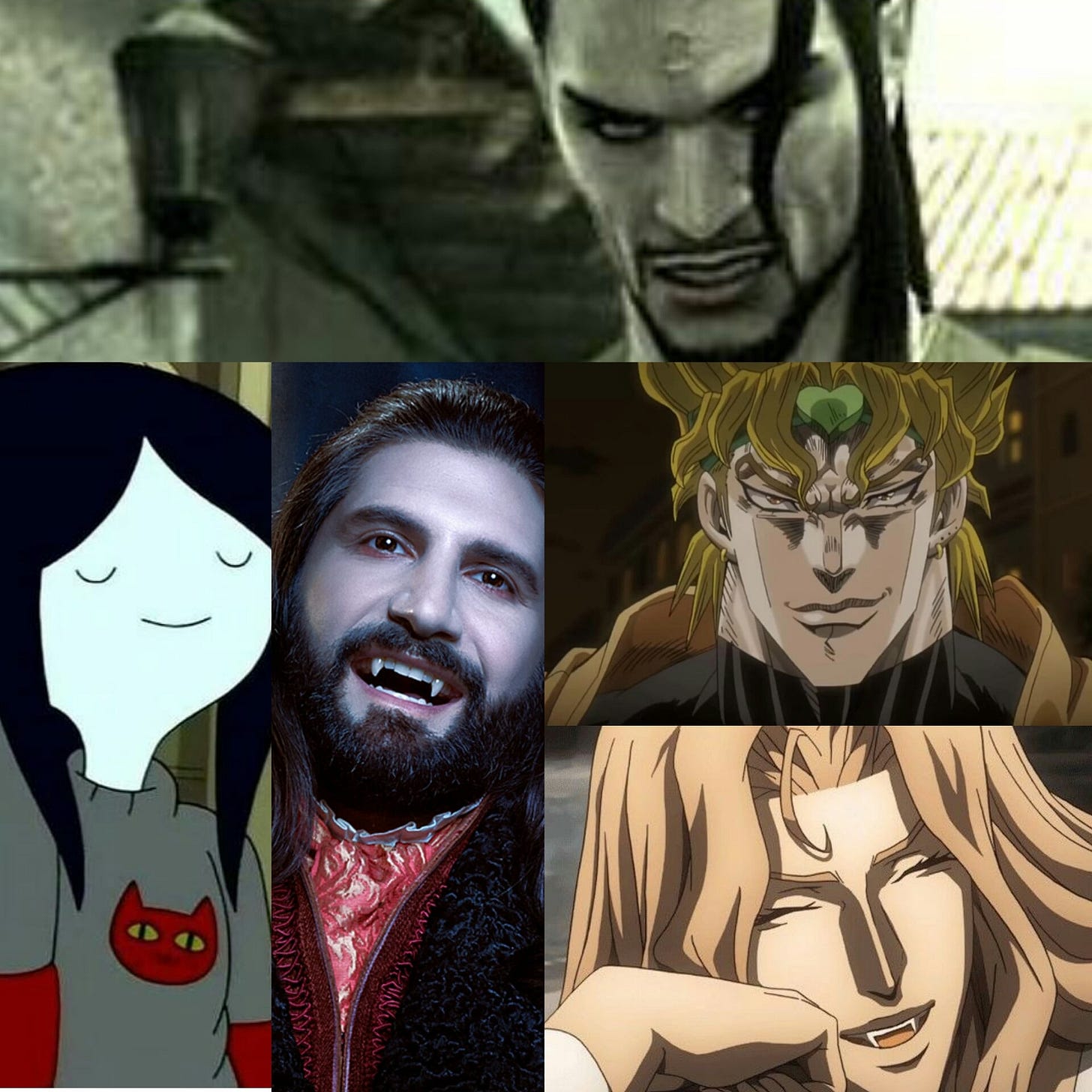Vampirism as a Sexual Metaphor
My reaction to Nosferatu and some viewers issues with the film.
The Sexuality of Nosferatu (2024)
Vampirism is inherently sexual. Yet some still despise a mention of it.
At 9pm on a Tuesday night with my girlfriend, I found myself scared in the cinema watching Robert Egger’s Nosferatu, and as I walked out of the cinema close to midnight, to the bus and walking home in the fog, cold, dark and eerie night, I wrote a very long review over on my letterboxd. This film was brilliant.
Yet, as I was doomscrolling on IG reels the next day, I came across a common thread in regards to the Virgin on the back of a white horse being sacrificed scene. The creator was knowledgeable on the topic and was trying to educate the audience as to be reasoning and folklore history behind that scene, she knew what she was talking about.
However, there were still a section of people in the comments who found that the placement of such scene was completely unnecessary and dirty, disregarding the Slavic/Balkan history of why they did such a thing. Plunging a stake into the heart of a vampire corpse whilst symbols of purity and cleanliness were brought to it is a common protective ritual - yet apparently it was ‘exploiting young women’s bodies’.



In regards to these comments specifically, I do not understand where they think young women’s bodies were exploited. As far as I remember, there were 2/3 scenes with a naked woman, one of which being the aforementioned tradition dating centuries. The other two scenes are a sex scene, and the opener to the film where Ellen is naked and unconscious in the garden following her sexual assault by Count Orlok.
I will not comment on the necrophilia aspect of Nosferatu, other than that, it was just yet another effect of the all-encompassing trance and madness that Count Orlok brought in his plague of the town. This essay is on Ellen and Orlok, and perhaps I'll go into necrophilia in another essay… what joyful topics I write about !
This film is about this topic of Ellen's domination by Orlok. The exploitation of him. This is necessary. Egger’s Nosferatu is about Count Orlok stopping at nothing to own a woman. It is sexual conquest, it is not a light topic, it is a tough one. The film begins with Ellen’s cry out for a celestial God, anything magic or spiritual to comfort her, and what she did was wake a creature who would trap her for life, leave her unconscious in the garden after playing with her flesh and assaulting her whilst she was a girl.
The film is not erotic, in fact I think it rejects that outright. By no means was any of this film supporting, in my opinion, ‘the male gaze’. Using nudity does not mean it is sexualising an actress for the men in the crowd, Lily Rose-Depp has been naked in film before and I doubt this will be the last time too, as an actress she seems comfortable with roles that involve sexuality to some extent - this film was not about showing sexuality to be beautiful, sensual and intimate - it was about devouring a woman sexually, total domination.
Ellen is tormented by her assault, dealing with nightmares, seizures, bouts of depression, and screaming fits for the rest of her life, only for the men around her to claim she’s crazy, rather than tortured and afraid. She is owned psychologically by a creature of another realm who took advantage of her loneliness following her mother’s death and father’s disagreeable nature. She felt alone, she called out for God but what met her was Orlok’s sexual deviance.
From then on she could never be alone, even if she wished to be. No matter where she went, he could find her. To the point where she cried out in pain to her husband, the one who rid her from Orlok’s grasp and played (how typical) a male saviour role, despite his failure to save her in the end. This creature reached her in dreams, in the night and called to her.
Yet, there was something intensely beautiful and vulgar about this film. The most striking quote to me was when Ellen said "you cannot love" to Orlok, in the flesh, she was unafraid of him. A plaguing demon who will bring nothing but wreckage, turmoil, anger, chaos, blood and death to all and any that he pleases is simply vanquished by one woman willingly ‘loving’ him and willingly giving herself to him, despite the beastly inability to love, and full capability to dominate- it's sacrificially beautiful, her surrender to the abuser - it was horrifying, but beautiful nonetheless.
This woman was non-consensually bound to a demon, but also simultaneously chained to a godless land, with crosses painted on doors, placed before the vampires home and everywhere in the film, a false god who protected them from nothing - Ellen was left tied to Orlok, tied because of her father's mistakes, his lack of care and love. The woman became plagued by demons yet all who knew her claimed she was just troubled, and needed God, yet she knew she was tormented by a forced lover who controlled her in her pain, until a real, true lover came to her. Thomas.
Her father's mistakes were partially absolved by Thomas and Ellen’s marriage but all came flooding back in the name of a capitalistic greed for more money and more treasure to "improve" their lives, Thomas in the end led Count Orlok right back to Ellen, the same way her father forced her to him in the first place.
Yet the comments still say complain that the film was exploiting young women’s bodies.
The film did all of this storytelling, displayed all of this torment, presented all of this horror and anguish and pain and disgust and inescapable terror with just three scenes involving nudity which were not even fully necessary and were simply choices made to further immersion.
Nosferatu did not exploit women’s bodies, it showed what exploitation does to a human, how it drives someone into such anguish that they are left with no choice but to die.
There is no romance inherent to Ellen’s demise with Orlok, instead, it is a relationship built on the vampires desire to conquest and own her, shaped by Ellen’s fear, Orlok’s manipulation and his toxic, violent town-plaguing and killing obsession with the lonely girl he claimed when she was desperate for love.
But I don't think these comments care as much as I do, maybe I'm thinking too much.
Sexuality in other vampirical media
This sort of comment fascinated me, because to me in Nosferatu, I think they approached the topic of sexuality in a very tasteful fashion. Vampires are inherently physical creatures, biting someone and sucking them dry of blood is a strongly sexual encounter, and that theme is present in vampirical literature, films, TV shows and all forms of media. In fact, its glorified and encouraged in some very popular vampire based media, like ‘The Vampire Diaries’, ‘Twilight’, and ‘The Vampire Chronicles’ - each of these usage vampirism as a sexual metaphor, for many different ends.
Vampires have a trait between them they all share, using coercion, whether that be in some form of psychological trickery or plain charisma to get what they want from humans: blood, sex, or perhaps both.
Therefore, looking at these comments, I did not understand where they were coming from, especially in regards to a direct retelling of Bram Stoker’s ‘Dracula’, the most recognisable and famous vampire story. Looking at the historical context of the book, Christian ideals were the norm in England, and acts of a sexual nature were strictly private and must be lawfully between a man and a woman.
Stokers Dracula, and particularly the film by Francis Ford Coppola of the same name, have erotic elements to them that Egger’s Nosferatu doesn't have. Particularly in the film too, Is Mina actually giving her consent to Dracula in Bram Stoker’s Dracula or is she just under his spells and charm? There's a lot of mysticism in vampire media, and it leaves a lot to be question about vampires as sexual creatures.
Vampirism continuously challenges gender norms, with acts of sucking blood, close intimacy and charismatic charm of vampires preying on both men and women. This whole pretence is essential for vampires, because in all human contexts, closeness, intimacy and biting is not socially acceptable in public, with strangers and in close relationship contexts. The only context this is suited to are ones of romantic and sexual nature.
Because of this, we saw vampires demonised and villainised because of their sexual nature. In early works, vampires were often depicted as sexual predators who violated people's privacy, especially girls and women, and were folktales designed to keep women safe at night, away from the ‘vampires'‘. They were sexual creatures as a folk walk of keeping safe.
Similarly, in the context of Bram Stoker in the 19th century, when sex was still strongly taboo, vampires were depicted as sexual beings to frighten people. The fear that came from forced sex, rape, and intimacy was designed to scare people since sex a forbidden subject and deemed a shameful thing, an act to fear. Thus a creature whose charm and premise was inherently sexual, that made it fearful - alongside the obvious death element too.
Vampire stories often explore sexual ambiguity, and some canonically queer vampires have appeared as early as the 19th century. This whole element of vampirism being a way to explore gender, and especially bisexuality is incredibly interesting and important to tellings of the creatures.
Some media likes vampires to be very sexual with just women, like how Damon keeps a news reporter be finds attractive as a way to feed in ‘The Vampire Diaries’, yet other media uses vampires to be openly bisexual, and pray on gay men just as much as straight women in other media.
Even Bram Stoker’s Dracula was deeply queer Bram writing a story which has aspects of his own self inserted into the book, as many scholars do believe Stoker was a closeted gay man, and that's shown in the homoerotic elements found in Dracula, and his praise of both Oscar Wilde and Walt Whitman, openly gay/queer men at the time.
Victorian-era stereotypes of gay men, is found in Dracula, including the vampires focus on beauty, charm, and a predatory nature towards other men. This wasn't unusual in the genre at the time as Carmilla. The lead character of Carmilla is the true first example of the lesbian vampire, where ‘Carmilla’ the female vampire, clearly showed her romantic desires toward the protagonist, another woman.
Tying this back to Dracula, being the most influential piece of vampire media of all time, it allowed Stoker to display homosexuality without facing so much religious shade and discrimination, as he used it in an already sinful character, an anti-christian vampire.
So, when we talk about Vampirism, we are not just talking about bloodsuckers who prey on their food. We are talking about representations for authors repressed sexuality, we are talking about eternal living beings exploring their sexuality and their love, we are looking at perhaps the strongest sexual metaphor in all of literature.
Because really, don't we all like to bite our partners sometimes?










this is so interesting!! i haven't seen nosferatu yet but it's fascinating how all these vampire tropes connect in terms of sexuality. i remember seeing the vampire lovers for the first time and being changed psychologically lol !! it really is such a historically significant metaphor for desire
I completely loved this film and found it so heartbreaking in its representation of assault and grooming, it got the point across so well while also being a visually enchanting film (gothic horror is always a favourite aesthetically), it was upsetting to see how the message seemed to go over so many peoples heads and how sexualised it was ! thank for you this beautifully written piece : D